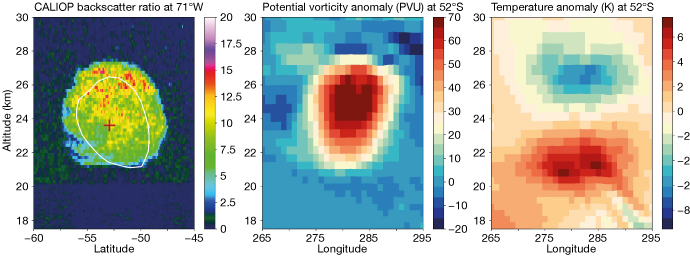A research study by scientists from France and ECMWF has revealed the ability of the operational ECMWF Integrated Forecasting System (IFS) to accurately analyse long-lived smoke-charged vortices in the stratosphere.
The ECMWF analysis
The Australian ‘Black Summer’ was marked by exceptionally strong pyro-cumulonimbus (PyroCb) activity in the south-east of the continent, with 5.8 million hectares of forest burnt. The strongest PyroCb outbreak occurred on New Year’s Eve. It lofted a colossal cloud of smoke-ice mixture to 15 km altitude. Already two weeks later, it became clear from satellite observations that the magnitude of stratospheric perturbation from this single PyroCb event had tripled that of the record-breaking 2017 Canadian wildfires. The biggest surprise came when we realized that the ECMWF operational IFS analyses were revealing an organised anticyclonic vortex that encompassed the rising smoke bubble. This vortex, created and maintained by the localized radiative heating of the absorbing smoke cloud, kept the bubble confined by strong winds during its entire life. The left panel of the figure shows a vertical cross section of the smoke cloud observed by the CALIOP space-based lidar instrument on 31 January 2020. The large smoke bubble had a vertical extent of 5 km and horizontal extent of 1,000 km. The other panels of the figure show that the IFS was able to analyse the anticyclonic vortex (large potential vorticity) and the extensive warming at the bottom/cooling at the top of the vortex. It lasted for about three months, during which it travelled 66,000 km and rose from 16 to 35 km. The whirling bubble contained not only the smoke particles but also several megatons of water and carbonaceous gases. Ozone concentrations were found to be very low inside the bubble, thereby creating a synoptic- scale ozone hole.

Understanding smoke clouds
The operational IFS only uses aerosol climatology, so the smoke cloud was not analysed directly. It is a remarkable achievement that the ECMWF analysis still managed to detect the smoke bubble. This was due to the thermal signature of the vortex, a vertical dipole of ± 5 K. The thermal signature was primarily detected by hyperspectral sounders (e.g. IASI, AIRS and CriS) and GPS radio occultation data (primarily from Metop), which are assimilated by the IFS. Hyperspectral data and GOME-2 ozone data ensured an accurate representation in the IFS of the ozone hole associated with the vortex. The main vortex was accompanied by two less intense companions that lived about one month each and were also represented by the IFS. Similar events were also detected after the Canadian fire of 2017.
Understanding the ability of smoke clouds to self-organise into structures lofting themselves to high altitude is a new challenge for geophysical fluid dynamics. This ability is also a factor that increases the residence time of smoke plumes and their effect on the climate, which is comparable to moderate volcanic eruptions of the last decade.
For more details on the research study, see the Nature Communications Earth & Environment article by Khaykin et al. (2020), https://www.nature.com/articles/s43247-020-00022-5 .

